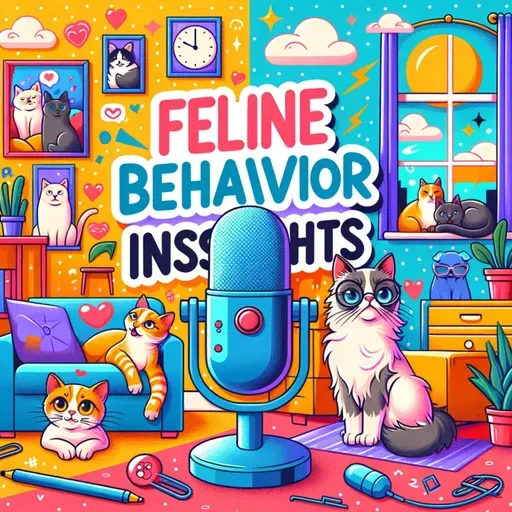
14 September 2025
"Decoding Feline Signals: Unlocking the Mysteries of Cat Behavior"
Feline Behavior Insights
About
Cats are among the most enigmatic creatures sharing our homes, full of subtle signals and startling surprises. Their behaviors whisper stories of wild ancestry and complex communication, often leaving listeners curious about what those twitches, purrs, and gazes really mean. MedVet explains that cats nap frequently because of deeply rooted instincts to conserve energy, a trait from their days as hunters. You might see your cat basking in a sunny spot, seeking warmth that soothes their higher-than-human temperature.
Kneading, that rhythmic paw pressing against blankets or even your lap, also traces back to kittenhood. According to MedVet, this behavior starts while nursing and continues as a sign of comfort or contentment, sometimes even marking territory with scent glands in their paws. When your cat brings you a “gift” like a toy or, for outdoor explorers, a small animal, it isn’t meant to shock or annoy. This gesture, rooted in their instinct to share prey, is a sign that you’re considered family.
Tail positions tell powerful stories. If your cat’s tail stands tall and relaxed, Express Vets Buford notes this as a reliable sign of confidence and happiness. However, when a tail puffs up, it signals fear or agitation, a way to appear bigger and more threatening. Tail flicks could mean they’re engaged with a toy or perhaps edging toward annoyance if no obvious play is involved.
Penn Today highlights that cats interpret human behavior and form secure bonds with their owners, sometimes using body language that includes slow blinking. That languid, half-closed gaze is considered a sign of trust, an invitation to slow blink in return and strengthen your connection.
Not all feline signals are joyful. Paoli Vetcare reports that aggression can emerge from anxiety, territorial urges, or fear, while stress may manifest as urination outside the litter box or sudden changes in appetite. Ear and whisker position are crucial cues. Forward ears signify alert curiosity. Flattened ears warn of fear or discomfort. MedVet emphasizes that a flicking tail and twitching ears might indicate excitement or mounting irritation.
Vocalizations round out cat communication. Meows are mostly reserved for humans, while hissing and growling are universal signs of distress or threat. Purring, according to MedVet, isn’t always a sign of contentment. Cats may also purr when in pain, seeking comfort for themselves. Nighttime “squalling,” or loud vocalizing, often links to mating instincts or the desire for attention.
Understanding these cues unlocks the feline world. Listeners, paying close attention to your cat’s body language, voice, and rituals not only improves their well-being but also fortifies your relationship. Thank you for tuning in and be sure to subscribe. This has been a quiet please production, for more check out quiet please dot ai.
For more http://www.quietplease.ai
Get the best deals https://amzn.to/3ODvOta
Kneading, that rhythmic paw pressing against blankets or even your lap, also traces back to kittenhood. According to MedVet, this behavior starts while nursing and continues as a sign of comfort or contentment, sometimes even marking territory with scent glands in their paws. When your cat brings you a “gift” like a toy or, for outdoor explorers, a small animal, it isn’t meant to shock or annoy. This gesture, rooted in their instinct to share prey, is a sign that you’re considered family.
Tail positions tell powerful stories. If your cat’s tail stands tall and relaxed, Express Vets Buford notes this as a reliable sign of confidence and happiness. However, when a tail puffs up, it signals fear or agitation, a way to appear bigger and more threatening. Tail flicks could mean they’re engaged with a toy or perhaps edging toward annoyance if no obvious play is involved.
Penn Today highlights that cats interpret human behavior and form secure bonds with their owners, sometimes using body language that includes slow blinking. That languid, half-closed gaze is considered a sign of trust, an invitation to slow blink in return and strengthen your connection.
Not all feline signals are joyful. Paoli Vetcare reports that aggression can emerge from anxiety, territorial urges, or fear, while stress may manifest as urination outside the litter box or sudden changes in appetite. Ear and whisker position are crucial cues. Forward ears signify alert curiosity. Flattened ears warn of fear or discomfort. MedVet emphasizes that a flicking tail and twitching ears might indicate excitement or mounting irritation.
Vocalizations round out cat communication. Meows are mostly reserved for humans, while hissing and growling are universal signs of distress or threat. Purring, according to MedVet, isn’t always a sign of contentment. Cats may also purr when in pain, seeking comfort for themselves. Nighttime “squalling,” or loud vocalizing, often links to mating instincts or the desire for attention.
Understanding these cues unlocks the feline world. Listeners, paying close attention to your cat’s body language, voice, and rituals not only improves their well-being but also fortifies your relationship. Thank you for tuning in and be sure to subscribe. This has been a quiet please production, for more check out quiet please dot ai.
For more http://www.quietplease.ai
Get the best deals https://amzn.to/3ODvOta